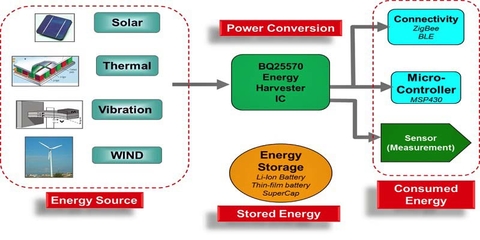Harvesting Energy From Motion: New Fiber Technology Unlocks The Power Of Piezos
Envision a wireless that energizes its battery as it rides on your hip. Or then again a remote sensor that gets its electrical force from the movements the gadget is detecting.
What about vibration damping advancements controlled by the very developments they're

stifling?
Such advancements might be the tip of an ice shelf. Progressed Cerametrics of
Lambertville, N.J., has built up another innovation that produces 10 time the
intensity of past energy-reaping materials while taking out their application-
restricting variables.
The innovation is an extremist new minor departure from an old and regarded methods for
gathering energy: piezoelectricity.
From power to movement, and the other way around
In 1880, Pierre and Jacques Curie found that specific gems create a charge
at the point when squeezed. They considered them piezo precious stones, from the Greek for "press."
Piezoelectric gems are transducers. They transform mechanical energy into power.
On the other hand, they react to electrical charges by extending or contracting.
Be that as it may, conventional piezoelectric mixes are massive, fragile and wasteful. They
convert close to 40 percent of mechanical energy to power. When
exposed to an electrical field or flow, they extend or contract, yet simply by small
sums.
Progressed Cerametrics piezoelectric filaments, then again, are adaptable. They
weigh as meager as two grams for a transducer that can produce 40 volts. They pick
up a more extensive scope of vibration frequencies, and create 75 percent more force
from those vibrations.
Progressed Cerametrics piezoelectric strands in an electric guitar pickup, for instance,
catch more stable from vibrating strings and hand-off that sound without pre-
enhancement!
Also, Advanced Cerametrics piezoelectric strands outflank mass piezos as
power to-movement transducers. They apply a more grounded mechanical power over a
bigger scope of movement at only 35 percent the weight. A two-gram dynamic fiber
composite strip can create an obstructing authority of 60 pounds!
Far-going applications
Progressed Cerametrics makes is piezoelectric filaments of lead zirconate
titanate, or PZT. Applications for PZT strands fall into the two general classifications,
energy harvesting reaping or activation. In particular, a couple of potentials for success have out.
Remote detecting
Remote detecting seems like an extraordinary thought until somebody asks, "Who's going to
change the batteries?" But on the off chance that batteries don't need to be supplanted on the grounds that they're
revived set up - or they're even dispensed with - the game flips completely around, and
the guarantee of remote detecting can be satisfied.
Most sensors are in conditions were surrounding waste mechanical energy is
plentiful, regardless of whether it's inside an air conduit or mounted on a mechanized framework.
Progressed Cerametrics PZT strands reap that mechanical energy to revive the
batteries or force the sensors straightforwardly, without batteries.
Applications for auto-controlled observing reach from aviation to car to
home apparatuses to biomedicine.
Lighting
The higher yield intensity of Advanced Cerametrics piezoelectric strands opens numerous
occasions to control electroluminescent lighting on extension decks, signage and
floats, among different applications.
Vibration damping
Progressed Cerametrics PZT composites transform movement into force and force into
movement. Vibration damping utilizes the two attributes. At the point when vibrations produce
power, inherent hardware transfers the charge to a microchip, which quantifies the
extent of the vibration and returns an intensified sign that either solidifies or
loosens up the fiber actuators. They qualify as "savvy frameworks" for their self-changing
nature.
In outstanding amongst other known uses of vibration damping is by Head Sport AG of
Kennelbach, Austria. Head utilizes Advanced Cerametrics PZT fiber composites to
diminish tennis racket vibration and ski babble.
General incitation
Progressed Cerametrics PZT fiber composites have a scope of movement that opens
totally new vistas for energy-to-movement activation. For instance, piezoelectric
filaments have been utilized to twist little airplane wing folds as much as 22 degrees
without hydrodynamics.
Regular mass piezos move such small sums that, when utilized as actuators,
they regularly require intermediating components that intensify development. The
more noteworthy scope of movement of fiber piezos may permit specialists to skirt these
intermediating gadgets.
Execution measurements
The measurements are great, and the innovation is propelling quick.
Multilayer overlay composites with PZT fiber:
o Voltage yield up to 400 Vpp
o PZT fiber measurement 10 µm to 250 µm
o Frequency is 10 kHz to 20 MHz
o No sidelong wave obstruction
o Remarkable part-to-part repeatability
o 10x the charge yield of other piezo structures
o User-characterized shapes open more opportunities for applications
o No critical debasement of composite properties in trial of up to 200 million
cycles
Outline and following stages
In our eager for energy, battery-controlled world, nineteenth century piezoelectric materials
have had little to contribute. In any case, adaptable piezoelectric strands from Advanced
Cerametrics offer multiple times the force yield of more seasoned structures. They can be formed in
ways the client characterizes. They're lighter, more delicate and have more noteworthy incitation
potential.
With these new filaments in the image, we're certain to see a surge of innovations that
exploit their properties.
What would be the best next step?
o Visit advancedcerametrics.com and click "ACI in the News" for articles and
specialized determinations.
o, Call Advanced Cerametrics at (609) 397-2900.